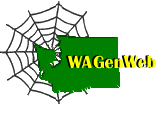Pioneer life in the Benton Co. WA area
Wildflowers Everywhere/Soda Boxes Kept for May Day
By BURTON 0. LUM
Tri-City Pioneer
Sunday, 21 May 1961
The Tri-City region was renowned amoung the early settlers for its beautiful wild flowers. The pioneers had their own names for each. Their Yellow Bells were one of the first wild flowers to bloom in the spring. They were told by their first little school Mam it was a Dog-Tooth Violet. To the pioneers roses were red and violets were blue. The early settler’s Blue Bells were not Blue Bells at all. They were a species of wild onions. The pioneers rather agreed to this, because, when their milk cows ate these Blue Bells, the milk had an oniony flavor. The butter churned from the cream of this milk would smell to high heaven. During the season of the growth and blooming of this wild onion, the pioneer’s children had to heard the cows away from the localities in which the plant grew.
Another early blooming wild flower was called Phlox. It did not belong to the Phlox family, although its pink flowers resembled the perennial Phlox. It was a semi-parasitic vine that grew on certain species of sagebrush. It had no fragrance.
The most brilliant wild floral display was the acres and acres of blooming prickly pear in the area now known as Finley. The pioneers would take their families in their wagons on Sunday afternoons to admire the gorgeous expanse of cerise, magenta and all shades of yellow. Greasewood Was Sickly Sweet One of the most fragrant wild flower blossoms was the bloom of a species of Greasewood. It was yellow in color and so fragrant it was sickening.
Another very fragrant wild flower was the White Poppy, so pungent that it was stupefying. This poppy was generally found in shady places. The wild Dog rose with its pink single blossom, at its height of bloom, would delicately scent the entire atmosphere. In the early times there were few Buttercups or Wood Violets in the Tri-City area. There were a few White Daisies.
On the banks of the Columbia there was an occasional Black-eyed Susan, also, now and then, a wild Bachelor’s Button.
As the seasons came, other wild flowers would blossom; Rosenweed with its yellow blossoms; wild Lupine of white, yellow and blue flowers; the blue, wild Foxglove; the wild yellow Sunflower; the wild blue Flag or Iris; the wild yellow Goldenrod that made the pioneer’s eyes water and his nose sneeze; wild yellow Stock; the wild geranium with its light green foilage and scarlet red blossoms.
Indians Dried Lilly Roots
There was the scarce sagebrush Lilly with its long stem and tulip like blossom of orchid color. It had a potato like root which the Indians dug and dried. These dried potatoes must have been quite nutritous. The squaws would always carry the hard dried potatoes when they were traveling. They would munch on them all day long. They ate no other food.
The weeds of this district were of many kinds. The barefoot children of the pioneers will never forget the Tar weed as it was called. It was a short, spiny weed with a small yellow blossom. When trod upon by a bare foot, it would shed hundreds of small spines between the toes. It was some chore to extract these spines.
The girls of the pioneers saved all the Arm and Hammer soda boxes. They would cover them with white paper, then attach a bale to it that could be hung over a door knob. May Day, the first of May, they would fill these baskets with wild flowers and hang them on the neighbors door knobs.
Other Flowers Grew Here
Much has been made of all the wild flowers that grew in this area years ago, but a sufficient number is given that the reader should be able to visualize the region as it existed then and at the present. The flowers seem to be the same today as they were seventy years ago.
Return to Index of Burton Lum Articles
